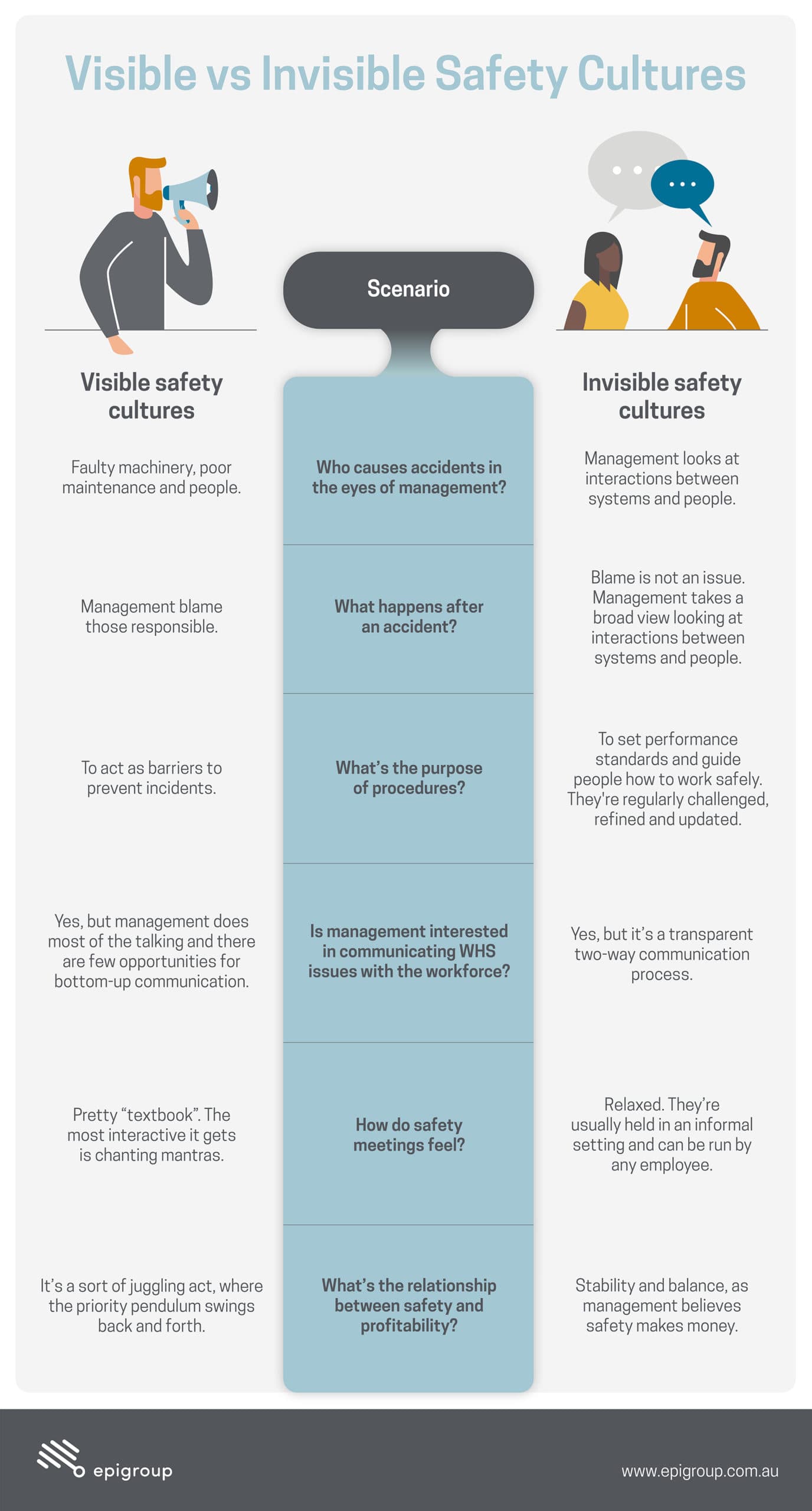Throughout your career, you’ve probably been exposed to a mixture of good and bad safety cultures.
When you think about the safety culture in your current workplace, what’s it like?
Is safety information wilfully ignored, messengers ‘shot’, responsibilities dodged, failures covered up, new ideas crushed, and a militant hierarchy which ensures people ‘stay in their box’? Hopefully not.
Or perhaps your organisation has moved beyond pathological and reactive safety behaviours. Instead, it has greater calculations and systems to manage hazards, which are put in place by an increasingly informed and trusted workforce.
Many organisations think this highly ‘visible’ safety culture equals a successful safety culture. While it sounds plausible, it has its drawbacks…
‘Visible’ Safety Cultures
What is a highly ‘visible’ safety culture?
A highly visible safety culture exists when:
- safety information is acted on (when it appears)
- messengers are… tolerated
- safety responsibilities are compartmentalised and dictated
- mercy is shown in the face of failure
- new ideas are raised but largely cause problems and are thrown in the ‘too hard basket’
- people are allowed to work in different areas of the organisation… but it’s not really encouraged.
A lot of organisations fit this description, so this probably sounds more familiar.
What are the pros of a highly visible safety culture?
- A continuous drive to improve safety within the company.
- Significant time and financial investments are made.
- Dedicated safety experts are employed and usually retained.
- A highly formalised safety system is created.
Although organisations with a visible safety culture can show how they’ve improved (and regularly like to do so), this kind of culture is largely bureaucratic. Safety is this ‘bolt-on’ function of an organisation, a necessary evil. And ‘red tape’ is just something we all need to deal with.
An excessive focus on rule-based or procedural safety is present, but often difficult to apply because the rules and procedures are written by people who are far away from the ‘sharp end’. Usually with a lack of, or outdated expertise.
Explore our safety culture surveys
‘Invisible’ Safety Cultures
What is an invisible safety culture?
So what does an ‘invisible’ safety culture look like? (Pardon the pun.)
Another way of thinking about an invisible safety culture is that it’s highly integrated and generative – safety is ‘just how we do business around here’.
- Safety information isn’t just acted on; it’s actively sought.
- Messengers aren’t merely tolerated; they are trained and rewarded – even when they bring bad news.
- Safety responsibilities are equally shared amongst everyone, rather than employing or appointing specific safety ‘pushers’.
- Failure is hunted down and studied rigorously, and an effective ‘just culture’ ensures everyone feels supported when failure occurs.
- New ideas are celebrated and efficiently acted on, the status quo is challenged, and people are rewarded for branching out and developing new skills.
What are the pros of an invisible safety culture?
- All of the above.
RELATED: Successful Safety Strategy Development – Part 1: The Who
Visible vs Invisible Safety Culture Examples
Key Takeaways
The aspects of safety cultures described are not rigid or dichotomous.
Organisations might be better in some areas than others, for example proactive in certain characteristics but reactive in others.
It’s a journey upwards across the ‘levels’ of safety culture. The dimensions touched upon in this article can improve in small increments, and each improvement adds to an increasingly informed workforce.
Most importantly, it increases the trust between everyone in the organisation. Trust is the currency of the future, not Bitcoin!
If you’d like to get an idea of where your safety culture sits, ask us about our safety culture surveys.



